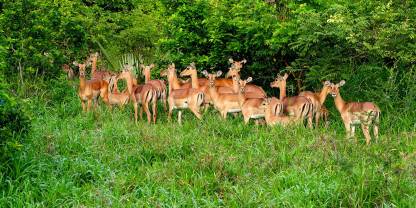Average Expert Rating
Rating Breakdown
Write a User ReviewWild Gorongosa Is One for Science, Conservation and Nature Enthusiasts
Gorongosa is a park for more experienced safari-goers. The wildlife here is still recovering after being hit hard by Mozambique’s 16-year civil war that ended in 1992 – the elephants are particularly nervous of people. But recovering it is, aided by rewilding efforts: wild dogs were introduced in 2018 and are thriving. The park’s wetlands are home to a rich birdlife and an enormous number of crocodiles. Gorongosa is a hub for research (several new species have been discovered in recent years) and it’s a brilliant destination for those interested in science, conservation and nature. Based on all the knowledge it’s possible to gather on a visit here and the access to real experts, it’s probably my favourite safari destination to date.
Glorious Gorongosa
In the 1950s Gorongosa attracted Hollywood A-listers like Ava Gardner and Gregory Peck, but later took center stage in the internecine conflicts in Mozambique, with both Renamo and Frelimo forces decimating the wildlife. Greg Carr, an American philanthropist, stepped in to save the park in 2004 and has since helped regenerate it to such an extent that it is now thriving. It’s been described as the most biodiverse park on the planet and new species previously unknown to science have been discovered here.
It’s beautiful too, with expansive golden plains, lakes and mountains, and fabulous fever-tree forests and palms.
Read more
The wildlife is returning with lion populations being restored, wild dogs making an appearance and absolutely masses of antelopes. I visited twice, five years apart, and was blown away by its progress during those intervening years. It’s been bruised and battered, but its beauty still shines through and I desperately want to return…Mozambique’s Conservation Flagship
One of Africa’s finest safari destinations during the colonial era, Gorongosa went through a lean time during the post-independence civil war, when it virtually served as a laager to the troops based within it. Since 2004, however, it has gained ground as a genuinely worthwhile safari destination, and the best non-marine wildlife-viewing destination in Mozambique. Our visit focused on the floodplains, where we saw plenty of waterbuck, reedbuck, impala and other antelope, as well as lion, elephant and buffalo, all at close quarters. We also enjoyed the dazzling variety of waterbirds on the floodplain, and made a side trip to climb nearby Mount Gorongosa, home to southern Africa’s only population of the eagerly sought green-headed oriole (we missed out, but our guide reckoned the odds of a sighting are 50/50). Overall, this is a fabulous work-in-progress, and it should only get better, though recent instability along the Beira Corridor – the main access road – has put an end to self-drive exploration.
On the Path To Recovery
Despite many setbacks created by political instability in the area, wildlife numbers have increased a lot, and the park runs a smooth operation for tourists once again.
We saw quite a lot of wildlife during our stay. Highlights were a herd of elephants drinking at a marsh in the forest and a lone young lion walking casually along the road. A close-up encounter with a majestic sable antelope bull was a treat as well.
From the main camp we went on a day trip to Mount Gorongosa, known as a birding hot spot. We ticked off several lifers, including the sought-after green-headed oriole. After all the hype it was remarkably easy to find due to its distinctive

